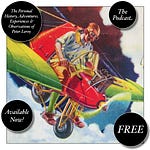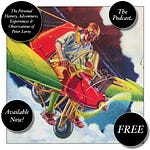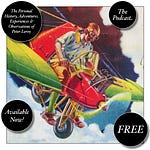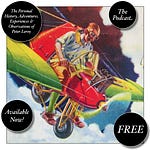I TRIED to persuade Matthew and Effie to stay for my thirty-fourth reading from Dead Air, “The Persistence of Memory,” because it was one of two episodes — the other being number forty-nine, “Shame on Me” — that I would have wanted Matthew, especially, to hear, but he said that he had no idea how much time he had before he fell across the threshold of the hospital entrance and died, and he wanted to cram as many experiences into his last moments as he could, even if those experiences were figments of his imagination, so they checked out and said goodbye, perhaps forever, and Tony T ferried them across the bay.
MANY YEARS AGO, I became a master builder of “electric eyes,” gadgets that could detect the presence or absence of light. I made them from a kit, 101 Fascinating Electronics Projects, and I incorporated them in an advanced type of flying-saucer detector that also included a relay and an electric doorbell. I squeezed all the bits and pieces onto the pegboard rectangle that came with the electronics projects kit so that the whole thing looked neat and complete, as if it were everything a flying-saucer detector ought to be, everything a flying-saucer detector could be, and perhaps it was, since I found that I had no interest in trying to improve the design further. I was willing to keep turning them out whenever someone wanted to buy one, but I grew tired of building the same project all the time, while the hundred others that the kit promised were waiting to be tried.
With every kit that I ordered I received a manual with full instructions for assembling all 101 projects. They were handsomely printed, with each project presented in a schematic diagram and in a series of step-by-step “pictorials,” drawings of the work as it was supposed to progress as the builder performed it. Throwing the manuals away seemed wasteful, so I stacked them on a shelf as they accumulated, and I sometimes read one of them in bed at night, as I might have read a story. As I read, I experienced the identification that one sometimes feels with the protagonist in a story: I identified with the unnamed someone who was assembling the projects depicted in the step-by-step drawings. Because of the way the manual was arranged, starting with the simplest project and moving through ninety-nine others to the most difficult, this unseen someone — a teenage boy, I imagined, not too much older than I — seemed to travel a road that I wanted to travel. He seemed to become, thanks to 101 fascinating electronics projects, the capable and sure-handed fellow I hoped to become.
I wanted to follow in his footsteps, to go somewhere I hadn’t been, make something I hadn’t made, but I found that most of the projects already bored me. Given the nature of the kit, the fact that each of the projects was built on the same pegboard base, with the same basic components in the same relative positions, all 101 projects looked very much alike, so there wasn’t much reason to choose one of them over another in that respect. Since they all functioned differently, the choice would be made on the basis of function, not form, but the manuals never made any mention of what it was like for the mystery builder to use the things that he had built. Previously, when I read through the manuals, I had imagined building each project; now I imagined owning and using each one. I grew tired of most of them quickly, but of one of them I did not grow tired, and that was the one I built.
When I summoned my friends Raskol, Marvin, Matthew, and Spike to see what I’d made, I said, “Wait till you see what I made,” full of builder’s pride. They came to my house at once, and when I said, “It’s in the cellar — come on down,” they followed where they were led. They were my pals.
I indicated the completed project on my workbench. “What do you think?” I asked.
“Is it another saucer detector?” asked Spike.
“No, no, no,” I said, chuckling indulgently.
“It looks like a saucer detector,” said Raskol.
“True,” I said, enjoying myself enormously.
“Well, since it looks so much like a saucer detector, I think you shouldn’t have used that tone of supercilious indulgence when you told Spike that it wasn’t what you must have known it would appear to her to be,” said Marvin.
“Oh,” I said. “Well, I just — ”
“You just brought us down here to demonstrate that you know something we don’t,” Spike suggested.
“No. No. I — ”
“You’re just showing off the fact that you can tell a saucer detector from whatever this is. The whole point of getting us down here is to rub our noses in the fact that even though it looks like the same bunch of electrical gadgets to us, to your eye, the eye of an initiate in the arcana of electronics, it is something altogether different,” said Matthew.
“No, really,” I said. “I only wanted to — ”
“You only wanted to play big shot,” said Marvin, “to show us that you’re an adept, while we’re the rubes, gawking at the mysteries in the sideshow of life.”
“Hayseeds,” said Spike.
“Bumpkins,” said Raskol.
“Ignoramuses,” said Matthew, and the four of them turned and started for the door with their heads down, apparently wounded to the depths of their souls, wounded beyond repair.
“B — but don’t you want to know what it is?” I asked. I may have moaned.
Slowly, they turned. Slowly, they smiled.
“Of course we do,” said Raskol. “What the hell is it?”
“It’s a transmitter!” I said. “We can broadcast with it. We can be on the radio, and — and — ” Shame and gratitude overwhelmed me. “I’m sorry,” I said.
“Forget it,” said Matthew, but I never did.
[to be continued]
Subscribe to The Personal History, Adventures, Experiences & Observations of Peter Leroy
Share The Personal History, Adventures, Experiences & Observations of Peter Leroy
Watch Well, What Now? This series of short videos continues The Personal History, Adventures, Experiences & Observations of Peter Leroy in the present.
Have you missed an episode or two or several?
You can begin reading at the beginning or you can catch up by visiting the archive or consulting the index to the Topical Guide. The Substack serialization of Little Follies begins here; Herb ’n’ Lorna begins here; Reservations Recommended begins here; Where Do You Stop? begins here; What a Piece of Work I Am begins here; At Home with the Glynns begins here; Leaving Small’s Hotel begins here.
You can listen to the episodes on the Personal History podcast. Begin at the beginning or scroll through the episodes to find what you’ve missed. The Substack podcast reading of Little Follies begins here; Herb ’n’ Lorna begins here; Reservations Recommended begins here; Where Do You Stop? begins here; What a Piece of Work I Am begins here; At Home with the Glynns begins here; Leaving Small’s Hotel begins here.
You can listen to “My Mother Takes a Tumble” and “Do Clams Bite?” complete and uninterrupted as audiobooks through YouTube.
You can ensure that you never miss a future issue by getting a free subscription. (You can help support the work by choosing a paid subscription instead.)
At Apple Books you can download free eBooks of Little Follies, Herb ’n’ Lorna, Reservations Recommended, Where Do You Stop?, What a Piece of Work I Am, and At Home with the Glynns.
You can buy hardcover and paperback editions of all the books at Lulu.
You’ll find overviews of the entire work in An Introduction to The Personal History, Adventures, Experiences & Observations of Peter Leroy (a pdf document), The Origin Story (here on substack), Between the Lines (a video, here on Substack), and at Encyclopedia.com.
















Share this post